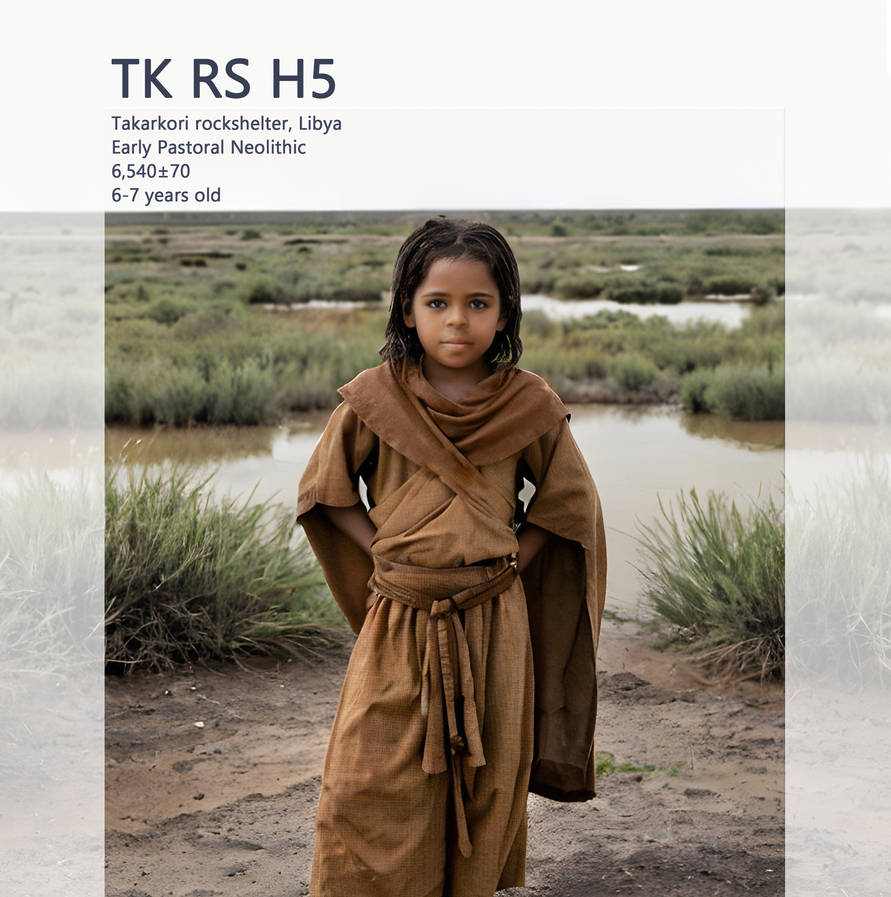Last edited:
You are using an out of date browser. It may not display this or other websites correctly.
You should upgrade or use an alternative browser.
You should upgrade or use an alternative browser.
Little Girl from the Earliest Pastoralists in Africa, Libya
- Thread starter datesfrompuntland
- Start date
Garaad Awal
Zubeyri, Hanafi Maturidi
Looks similar to modern Libyans & Egyptians.
Are you serious?Looks similar to modern Libyans & Egyptians.
Garaad Awal
Zubeyri, Hanafi Maturidi
Yes I’m serious. Do you think the girl looks Nigerian or Norwegian?Are you serious?
Uh she looks like a tebu girl, they live in southern Libya. not genetically related tho.Yes I’m serious. Do you think the girl looks Nigerian or Norwegian?
Garaad Awal
Zubeyri, Hanafi Maturidi
Tebu are black. This girl doesn’t look blackUh she looks like a tebu girl, they live in southern Libya. not genetically related tho.
NidarNidar
Punisher
Reminds me of the Siwa phenotype

Resembles the Riverine Northern Sudanese to a degree.
Hold on, I say hold there captain jump to assumptions.Yes I’m serious. Do you think the girl looks Nigerian or Norwegian?

yeh this toddler group is ancestral to lot of saharansReminds me of the Siwa phenotype
View attachment 326747
Garaad Awal
Zubeyri, Hanafi Maturidi
Modern Amazigh Siwans are heavily admixed with West African ancestry due to the slave trade.Reminds me of the Siwa phenotype
View attachment 326747
Doctorabdi
الوقت من ذهب
Tebu are black. This girl doesn’t look black
You don't have permission to view the spoiler content.
Log in or register now.
Last edited:
Doctorabdi
الوقت من ذهب
Modern Amazigh Siwans are heavily admixed with West African ancestry due to the slave trade.
You don't have permission to view the spoiler content.
Log in or register now.
Last edited:
I think so the guy who made it referenced them.Maybe it's an iberomaursian-like population. As we see many of those south
there's saharans who r native have been for 4kys+Modern Amazigh Siwans are heavily admixed with West African ancestry due to the slave trade.
Doctorabdi
الوقت من ذهب
The person does make quite a mistake, Iberomaursians were not "largely of west eurasian origin".They were 45 ANA 55 "Eurasian". He is using quite oudated data, secondly the Takakori people were likely much more sub saharan influenced compared to iberomaurisians due to the geography and genernal migrations.
Also calling them "proto-berbers" make little sense, berbers as a group did not exist back then.
Also calling them "proto-berbers" make little sense, berbers as a group did not exist back then.
"
6500 years ago was still part of a period known as the Green Sahara. The Sahara was not a desert during the African humid period. Instead, most of northern Africa was covered by grass, trees, and lakes.
The area had flowing water with wetlands nearby. There was a river called Wadi Tanezzuft and two notable lakes existed near Takarkori. Takarkori Lake and Garat Ouda. These lakes, along with series of other small lakes in the nearby dunes, supported diverse populations of aquatic flora and fauna. A large number of fish remains at Takarkori associated with this period indicate that people were routinely fishing near the rockshelter. Additionally, the presence of residues from plants such as potamogeton on potsherds show that humans at Takarkori were processing aquatic flora as well.
Most of the people in the region at the time were descended from Iberomaurusian-like ancestry and it appears that the people of the Takarkori were no different. Natural mummies of two women buried at the rockshelter from a similar time to H5 were found to be part of mitochondrial haplogroup N. A haplogroup from Asia that is rarest in Sub-Saharan Africa, so like the Mechta-Afalou (Paleo-Berbers) and other Iberomaurusians, the Takarkori people were probably largely of West Eurasian origin.
There's not much information on H5 themselves even though most of the skeleton is intact. they were still too young to confidently determine their sex without DNA testing. I've put them down as Early Pastoral Neolithic because that was the culture one paper assigned although most of the area at the time was Middle Pastoral Neolithic.
The earliest pastoralists, who brought domesticated sheep, goat, and cattle along with them to the Central Sahara, amid the Pastoral Period (8000 BP – 7000 BP), have been characterized as Proto-Berbers."
Uan Muhuggiag - wiki
a close by group similar time periodalso a woman in the area of Libya was found with a lip plate in the garamantes section
Antonio Ascenzi, a pathologist, believes that Uan Muhuggiag and the surrounding area became inhabited around 10,000 BP by Negroid peoples, who followed the monsoon north.[17] It has been suggested that some time later, around 7000 BP, people from Mesopotamia and the Middle East arrived, introducing pastoralism to the region.[3] The idea of domestic cattle in Africa coming from the Fertile Crescent exclusively is now seen as having serious shortcomings.[18] As no hard archaeological evidence supports this claim and subsequent archaeology has revealed a deep well of cattle integration and early association of cattle with religious and subsistence strategies in Holocene Africa. More modern scholarship has instead found that the origins of pastoralism, cattle worship and cattle domestication lie most likely in areas of the Sudanese Nile Valley (e.g., Affad).[18][19] Several discoveries at Letti, in Sudan, suggest early burial and domestication of cattle, including early implements used to safely bleed cattle without harming them. The cultural practice of drinking cow blood on special occasions is still shared to this day by many Nilotic cattle herding groups in Africa, such as the Maasai and Dinka.[20] One of the earliest burials of cattle can be found at the site of Nabta Playa, which had inhabitants that were of the same Nilo-Saharan traditions of Sudan and the broader Nile Valley.[21] These people were responsible for sacrificial cattle burials in clay-lined and roofed chambers covered by rough stone tumuli.[22] At one of the sites from the beginning of the Holocene (~10,000 BP), among the bones of wild fauna, remains of domesticated cattle with 'auroch-like' features were found. There is strong evidence that domestic livestock, principally cattle, played an important role in the lives of the inhabitants of Uan Muhuggiag, which is supported by the amount of cattle bones found at the site as well as evidence of a cattle cult and ritual sacrifice at a location in the Messak Plateau, approximately 60 miles in distance from the site.[3]
The Tashwinat mummy found at Uan Muhuggiag was one thousand years older than the oldest known Egyptian mummy. Its sophisticated form of evisceration indicates a highly advanced society.[6] Some scholars argue that the sub-Saharan African population living there could have had an influence on the process of mummification used in Ancient Egypt a thousand years later.[23][24][25]
Considerable debate also exists about whether the rock art found at Uan Muhuggiag along with the two mummies, signify that the shelter was a burial place or otherwise sacred. Mori was a strong advocate of this theory and believed that the site was a place where a cult of the dead took place.[2]
Trending
-
-
-
POLL: What region(s) of Somaliweyne are you/your family from?
- Started by empressjamila
- Replies: 76

